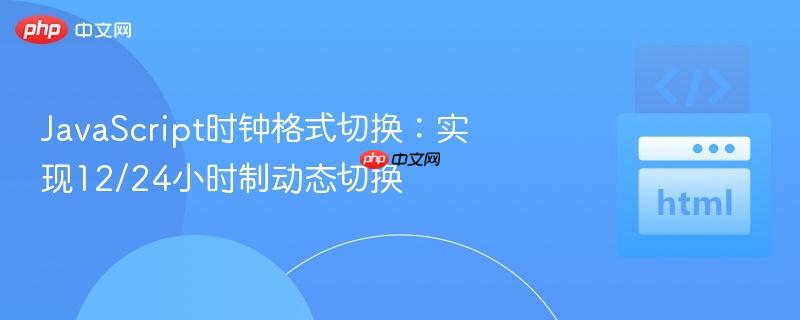
在Web开发中,创建一个实时更新的时钟是一个常见的需求。当需要提供多种时间显示格式(如12小时制和24小时制)并允许用户在它们之间切换时,就会遇到一个常见但关键的问题:如何确保在切换时只有一个时间更新逻辑在运行,以避免显示混乱或资源浪费。本文将深入探讨这个问题,并提供一个健壮的解决方案。
初学者在实现时钟格式切换功能时,常犯的错误是在每次点击切换按钮时都调用一个新的setInterval函数来更新时间,而没有停止之前运行的setInterval。
考虑以下场景:
setInterval函数会返回一个唯一的ID,这个ID可以用来在后续通过clearInterval()函数停止该定时器。如果不对这些ID进行管理,就无法停止不再需要的定时器。
立即学习“Java免费学习笔记(深入)”;
解决这个问题的核心在于,在启动新的定时器之前,必须先停止任何当前正在运行的定时器。这可以通过以下步骤实现:
通过这种机制,我们确保在任何时候都只有一个setInterval在运行,从而避免了冲突。
我们将通过HTML、CSS和JavaScript来构建这个可切换格式的时钟。
HTML部分定义了显示时间、日期以及两个切换按钮的容器。
<!DOCTYPE html>
<html lang="en">
<head>
<meta charset="UTF-8">
<meta http-equiv="X-UA-Compatible" content="IE=edge">
<meta name="viewport" content="width=device-width, initial-scale=1.0">
<title>动态时钟</title>
<!-- 字体链接 -->
<link rel="preconnect" href="https://fonts.googleapis.com">
<link rel="preconnect" href="https://fonts.gstatic.com" crossorigin>
<link href="https://fonts.googleapis.com/css2?family=Rokkitt:wght@100&display=swap" rel="stylesheet">
<link rel="stylesheet" href="style.css"> <!-- 引入CSS文件 -->
</head>
<body>
<!-- 时间和日期容器 -->
<div class="t-d-cont">
<div id="format">
<h1>24 Hour format</h1>
</div>
<div class="redline">
<div class="time-box">
<h1>Current Time: <span id="time"></span></h1>
</div>
<div class="date-box">
<h1> Today's Date: <span id="date"></span></h1>
</div>
</div>
<!-- 24小时制按钮 -->
<div class="dropdown">
<button class="dropbtn-2" onclick="clock_24();">24-hour-format</button>
</div>
<!-- 12小时制按钮 -->
<div class="dropdown">
<button class="dropbtn" onclick="clock_12();">12-hour-format</button>
</div>
</div>
<script src="script.js"></script> <!-- 引入JavaScript文件 -->
</body>
</html>CSS部分负责页面的布局和美化,与时钟逻辑本身无关,但提供了良好的视觉体验。
* {
margin: 0;
padding: 0;
}
.t-d-cont {
background-color: gray;
margin: 50px;
padding: 50px;
}
#format {
border-left: 2px solid rgb(70, 166, 239);
margin-bottom: 20px;
padding-left: 20px;
font-weight: bold;
}
.redline {
border-left: 2px solid red;
width: 100%;
padding-left: 20px;
}
.time-box {
margin-bottom: 50px;
}
#time {
font-family: 'Rokkitt', serif;
font-size: 45px;
}
.date-box {
margin-bottom: 30px;
}
#date {
font-family: 'Rokkitt', serif;
font-size: 45px;
}
.dropbtn {
background-color: #4CAF50;
color: white;
padding: 16px;
font-size: 16px;
border: none;
cursor: pointer;
}
.dropdown {
position: relative;
display: inline-block;
}
.dropbtn-2 {
background-color: #4CAF50;
color: white;
padding: 16px;
font-size: 16px;
border: none;
cursor: pointer;
margin-left: 15px;
}这是实现核心功能的关键部分。注意timer变量的声明和clearInterval(timer)的调用。
// 声明一个全局变量来存储定时器ID
let timer;
// 页面加载完成后,默认启动24小时制时钟
window.onload = (event) => {
clock_24();
};
/**
* 启动24小时制时钟
*/
function clock_24() {
// 在启动新定时器前,清除任何旧的定时器
clearInterval(timer);
const options = {
day: 'numeric',
month: 'long',
year: 'numeric'
};
// 设置新的定时器,并将其ID存储在timer变量中
// 注意:这里使用1毫秒的间隔,这对于普通时钟来说过于频繁,通常1000毫秒(1秒)即可
timer = setInterval(() => {
const a = new Date();
const date = a.toLocaleDateString(undefined, options);
const hours = String(a.getHours()).padStart(2, '0');
const min = String(a.getMinutes()).padStart(2, '0');
const sec = String(a.getSeconds()).padStart(2, '0');
const milli = a.getMilliseconds(); // 包含毫秒,这在1ms间隔下才有意义
const time = hours + ':' + min + ':' + sec + ':' + milli;
document.getElementById('time').innerHTML = time;
document.getElementById('date').innerHTML = date;
}, 1); // 1毫秒更新一次,非常频繁
// 更新格式显示
document.getElementById("format").innerHTML = "24 Hour format";
document.getElementById("format").style.fontSize = "32px";
document.getElementById("format").style.fontFamily = 'Times New Roman';
console.log('24-hour clock loaded');
}
/**
* 启动12小时制时钟
*/
function clock_12() {
// 在启动新定时器前,清除任何旧的定时器
clearInterval(timer);
// 设置新的定时器,并将其ID存储在timer变量中
timer = setInterval(() => {
const dateObj = new Date();
let hh_12 = dateObj.getHours();
const session_12 = hh_12 >= 12 ? "PM" : "AM";
// 转换为12小时制
hh_12 = hh_12 % 12;
hh_12 = hh_12 === 0 ? 12 : hh_12; // 0点显示为12点
hh_12 = String(hh_12).padStart(2, '0');
const mm_12 = String(dateObj.getMinutes()).padStart(2, '0');
const ss_12 = String(dateObj.getSeconds()).padStart(2, '0');
const tt_12 = hh_12 + ":" + mm_12 + ":" + ss_12 + " " + session_12;
document.getElementById('time').innerHTML = tt_12;
// 更新日期
const options = {
day: 'numeric',
month: 'long',
year: 'numeric'
};
const date = dateObj.toLocaleDateString(undefined, options);
document.getElementById('date').innerHTML = date;
}, 1000); // 1000毫秒(1秒)更新一次
// 更新格式显示
document.getElementById("format").innerHTML = "12 Hour format";
document.getElementById("format").style.fontSize = "32px";
document.getElementById("format").style.fontFamily = 'Times New Roman';
console.log('12-hour clock loaded');
}通过引入一个全局变量来管理setInterval的ID,并在每次切换时清除旧的定时器并启动新的,我们成功地解决了JavaScript时钟格式切换时可能出现的定时器冲突问题。这个模式不仅适用于时钟,也适用于任何需要动态切换或停止周期性任务的场景,是JavaScript异步编程中的一个重要概念。理解并正确运用setInterval和clearInterval是构建稳定、高效Web应用的基础。
以上就是JavaScript时钟格式切换:实现12/24小时制动态切换的详细内容,更多请关注php中文网其它相关文章!

每个人都需要一台速度更快、更稳定的 PC。随着时间的推移,垃圾文件、旧注册表数据和不必要的后台进程会占用资源并降低性能。幸运的是,许多工具可以让 Windows 保持平稳运行。

Copyright 2014-2025 https://www.php.cn/ All Rights Reserved | php.cn | 湘ICP备2023035733号